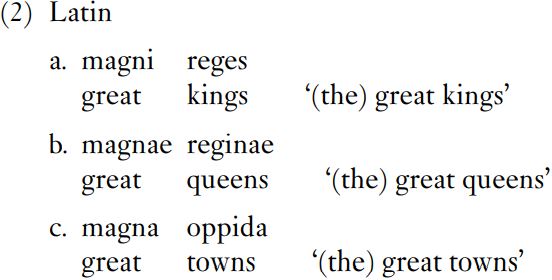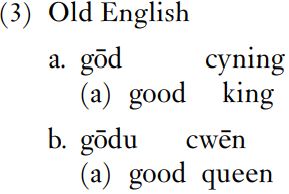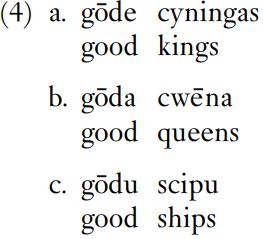

Grammar


Tenses


Present

Present Simple

Present Continuous

Present Perfect

Present Perfect Continuous


Past

Past Simple

Past Continuous

Past Perfect

Past Perfect Continuous


Future

Future Simple

Future Continuous

Future Perfect

Future Perfect Continuous


Parts Of Speech


Nouns

Countable and uncountable nouns

Verbal nouns

Singular and Plural nouns

Proper nouns

Nouns gender

Nouns definition

Concrete nouns

Abstract nouns

Common nouns

Collective nouns

Definition Of Nouns

Animate and Inanimate nouns

Nouns


Verbs

Stative and dynamic verbs

Finite and nonfinite verbs

To be verbs

Transitive and intransitive verbs

Auxiliary verbs

Modal verbs

Regular and irregular verbs

Action verbs

Verbs


Adverbs

Relative adverbs

Interrogative adverbs

Adverbs of time

Adverbs of place

Adverbs of reason

Adverbs of quantity

Adverbs of manner

Adverbs of frequency

Adverbs of affirmation

Adverbs


Adjectives

Quantitative adjective

Proper adjective

Possessive adjective

Numeral adjective

Interrogative adjective

Distributive adjective

Descriptive adjective

Demonstrative adjective


Pronouns

Subject pronoun

Relative pronoun

Reflexive pronoun

Reciprocal pronoun

Possessive pronoun

Personal pronoun

Interrogative pronoun

Indefinite pronoun

Emphatic pronoun

Distributive pronoun

Demonstrative pronoun

Pronouns


Pre Position


Preposition by function

Time preposition

Reason preposition

Possession preposition

Place preposition

Phrases preposition

Origin preposition

Measure preposition

Direction preposition

Contrast preposition

Agent preposition


Preposition by construction

Simple preposition

Phrase preposition

Double preposition

Compound preposition

prepositions


Conjunctions

Subordinating conjunction

Correlative conjunction

Coordinating conjunction

Conjunctive adverbs

conjunctions


Interjections

Express calling interjection

Phrases

Sentences


Grammar Rules

Passive and Active

Preference

Requests and offers

wishes

Be used to

Some and any

Could have done

Describing people

Giving advices

Possession

Comparative and superlative

Giving Reason

Making Suggestions

Apologizing

Forming questions

Since and for

Directions

Obligation

Adverbials

invitation

Articles

Imaginary condition

Zero conditional

First conditional

Second conditional

Third conditional

Reported speech

Demonstratives

Determiners


Linguistics

Phonetics

Phonology

Linguistics fields

Syntax

Morphology

Semantics

pragmatics

History

Writing

Grammar

Phonetics and Phonology

Semiotics


Reading Comprehension

Elementary

Intermediate

Advanced


Teaching Methods

Teaching Strategies

Assessment
Agreement
المؤلف:
Jim Miller
المصدر:
An Introduction to English Syntax
الجزء والصفحة:
101-9
2-2-2022
1391
Agreement
Agreement is found inside noun phrases and, in some of the IndoEuropean languages of Europe, in the copula constructions – adjective complements of BE (and other copula verbs) agree with the subject noun. Agreement in noun phrases is exemplified in (1).


The phrases in (1a–c) could function as subjects of clauses. Reks in (1a), regina in (1b) and oppidum in (1c) are said to be in the nominative case, the case being signaled by the suffixes -s, -a and -um. The adjective translated as ‘great’ consists of the stem magn-[as in ‘magnify’ – to make great] plus various suffixes, -us, -a and -um. Which suffix is added is controlled by the head noun. *Magna reks is incorrect, as is *magnus regina. The nouns in (1a–c) have singular number; different suffixes appear both on the nouns and the adjectives when they are plural, as in (2).

The nouns in (2) are still in the nominative case and can still function as the subjects of clauses, but they are plural and have different suffixes, and the adjectives too have different suffixes. Whether, for example, the stem magn- takes the suffixes -us, -a, -i or -ae depends on what type of noun it modifies, what case the noun is in and whether the noun is singular or plural. That is, the noun is the controlling word but both noun and adjective change shape, that is, change their suffixes; this is why the term ‘agreement’ is used. The traditional formula is that adjectives agree with nouns in number and case (and also in gender, which is discussed below.) In spite of the traditional formula, we can view the noun as governing the adjective in case and number.
Old English had similar patterns of agreement between the head noun in a noun phrase and adjectives that modified it. Consider the examples in (3).


The nouns in (3) are in the nominative case. Cyning in (3a) is masculine, and scip in (3c) is neuter. The adjective in both examples consists of the stem go¯d, with no suffix. Cwe¯n in (3b) is feminine, and the adjective takes the suffix -u, go¯du. A richer pattern is observed when the head noun is plural, as in (4).

The masculine plural noun cyningas in (4a) is modified by go¯de with the suffix -e. The feminine plural noun cwe¯na in (4b) is modified by go¯da, with the suffix -a. Finally, in (4c) the neuter plural noun scipu is modified by go¯du, with the suffix -u. Although the adjective and noun in (3a) and (3b) do not change their shape, since no suffixes are added to the stem, all the nouns and adjectives in (4) do change their shape, since suffixes are added to both adjective and noun. Looking at the overall pattern for singular and plural, and for other cases, we can justifiably speak of adjective and noun agreeing in Old English.
 الاكثر قراءة في Syntax
الاكثر قراءة في Syntax
 اخر الاخبار
اخر الاخبار
اخبار العتبة العباسية المقدسة

الآخبار الصحية















 قسم الشؤون الفكرية يصدر كتاباً يوثق تاريخ السدانة في العتبة العباسية المقدسة
قسم الشؤون الفكرية يصدر كتاباً يوثق تاريخ السدانة في العتبة العباسية المقدسة "المهمة".. إصدار قصصي يوثّق القصص الفائزة في مسابقة فتوى الدفاع المقدسة للقصة القصيرة
"المهمة".. إصدار قصصي يوثّق القصص الفائزة في مسابقة فتوى الدفاع المقدسة للقصة القصيرة (نوافذ).. إصدار أدبي يوثق القصص الفائزة في مسابقة الإمام العسكري (عليه السلام)
(نوافذ).. إصدار أدبي يوثق القصص الفائزة في مسابقة الإمام العسكري (عليه السلام)


















